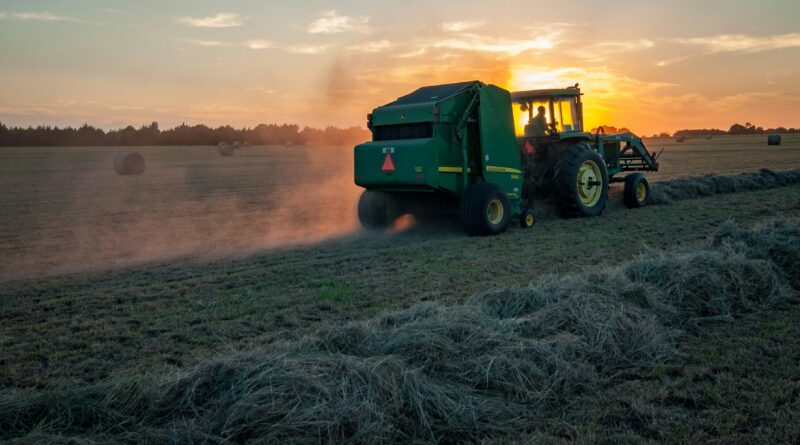Is Mechanization the Sole Solution to the Problems in Nigerian Agriculture?
It is almost cliche to say that Nigerian agriculture hasn’t reached its full potential. But where’s the lie? Ask anyone to give an overview of farming and agriculture in Nigeria. Nine out of ten people would focus on the problems. Such is the status quo surrounding the sector that few people ever think of the progress, if any.
Now ask ten more people to suggest solutions to these problems. Six out of ten may cite a lack of mechanization – maybe more. But who would blame them? Every day we read about technological advancement in agriculture in the developed worlds. Every time, trends in agritech pop up on our feeds. We see automated robots carrying out tasks meant for at least ten people. It looks so seamless and efficient that we rue being where we are as a nation.
Should these sophisticated machines find their way into Nigeria, boom! All our problems are solved. Bye-bye, poverty!
But is that really the case? Is mechanization the Jesus of our agriculture?

Analyzing the Solutions to the Problems in Nigerian Agriculture
According to Sahel Consult newsletter volume 17, Nigeria uses 0.27 horsepower per hectare. For every 10,000 hectares of arable land, Nigerian farmers have access to 6 tractors. These figures fall below FAO’s recommendation of 1.5 horsepower per hectare. When compared to countries like Thailand with about 281 tractors per 10,000 hectares of arable land, you’d understand the magnitude of the problem.
If Nigerian farmers had access to machines, their productivity would triple. Farming operations would be faster, livestock management would be seamless, and efficiency would be the order of the day. But the big question is, should we keep lamenting on poor mechanization? Is it the only solution? The answer is a resounding NO.
Smallholder farmers produce up to 90% of what we eat. They make up 80% of the farming population in Nigeria. These farmers are in rural areas and are characterized by poverty, illiteracy (including digital), and low living standards. Considering their profile, how far would mechanization go?
Can they afford to pay for the services, even if they’re subsidized? Can they afford to purchase a machine as small as a power tiller? If the government intervenes by introducing subsidies, is it a sustainable solution? Would the next government continue the subsidies?
These questions and more hover on the horizon. On paper, mechanization would be a game changer. But in reality, it takes time to see the long-term feasibility. Interventions like the government subsidies on tractors in Ekiti state are commendable. Farmers can access tractors at subsidized rates and enjoy the benefits that come with them.
However, the proportion of farmers with access to these dividends is worrisome. This is because most of the Nigerian farming population resides deep in rural areas. Most importantly, they are smallholder farmers with barely 1 hectare of land for production.
If the government were to take these interventions to the rural areas, rural farmers may be unable to afford them. In fact, as things stand, many farmers cannot afford improved seeds. They settle for recycled seeds that yield poor returns.
Hence, it’s safe to say that mechanization is a solution for a certain group of farmers. But it is not a general one. Let’s explore other solutions that are arguably as important as mechanization.

Agricultural Research
According to statistics, agriculture accounted for a meager 1.8% of the Nigerian budget In 2020, This is way below the 10% specified in the Maputo Distribution. As expected, this 1.8% must cater to every agricultural problem in the nation. This easily places Nigerian agricultural research as one of the least funded in the world. How then would new technology and innovative practices be fostered?
Agricultural research paves the way for an improved sector. They come up with innovative practices, new technologies, and advanced techniques. To truly improve the situation of agriculture in Nigeria, we must invest heavily in research. Research institutions across every subsector in agriculture must receive adequate funding to carry on their mandate. More than mechanization, this could change the lives of smallholder farmers. They can access affordable improved seeds, learn low-cost farming techniques, and improve their agronomic practices.
Extension Services
The current ratio of extension agents to farmers is between 1:5000 and 1:10000, with a total workforce of about 7000 public agents, according to a study by David et al. For example, in Katsina, the ratio is 1:10,000; in Edo, it is 1:9,375; and in Ebonyi, it is 1:8,723. This places us below the charts in the extension workers – farmers ratio globally. With such a crippled figure, should it be surprising that we’re playing catch-up to the rest of the world?
Extension workers bear the important task of disseminating technologies to farmers. They thrive on contact with farmers to demonstrate innovations. As a basic principle, extension agents help farmers improve their livelihood by utilizing their local resources. They bridge the knowledge gap and close the yield gap.
To exert their full effect, extension services should focus on two key areas:
- Teaching advanced agronomic practices.
- Breaking the digital divide.
For many Nigerian farmers, traditional practices, while familiar, may not be as productive or sustainable. Extension agents can equip farmers with the knowledge to make informed decisions. This could be by training them in improved soil management techniques, water conservation practices, crop rotation strategies, and integrated pest management (IPM).
The digital revolution happening globally is another focus area. However, many Nigerian farmers, particularly in remote areas, lack access to the internet and digital tools. This is where extension agents come in! They can organize workshops and demonstrations on using basic mobile phones. With this, farmers can access weather forecasts, market information, and agricultural advice.
NGO-Government Collaboration
The vastness of Nigeria and the dispersed nature of its rural population pose a serious challenge in delivering agricultural services. To effectively reach farmers in the most remote areas, collaboration between NGOs and the government is essential.
Many NGOs have established strong networks and relationships with rural communities. The government can leverage these existing networks and local knowledge. Through partnerships, they can deliver extension services, distribute improved seeds and fertilizers, and facilitate access to credit facilities for farmers in remote areas.
Joint capacity-building programs can have a massive impact on farmers’ lives, too. These programs designed by NGOs and the government can equip farmers with the necessary skills and knowledge to address the specific needs of remote communities. These programs can focus on using low-tech and cost-effective solutions that are adaptable to the local context.
Furthermore, public-private partnerships can attract private-sector investment in establishing mobile service networks, solar-powered irrigation systems, and local storage facilities in remote areas.
Access to Funds
Everyone would agree on how much of a problem this part is. Limited access to finance is a major constraint for Nigerian farmers. It hinders their ability to invest in essential inputs like improved seeds, fertilizers, and mechanization. Yes, mechanization!!!
One creative solution is farmers cooperatives. Farmers increase their bargaining power when negotiating with leaders or financial institutions in a cooperative. Cooperatives can also pool resources and access bulk discounts on agricultural inputs. For example, a cooperative of 100 farmers goes to Indorama to purchase Urea. Indorama would sell large quantities to the corporatives, instead of individual farmers. As a result, farmers enjoy discounts on inputs.
Additionally, the government or private enterprises can set up a robust warehousing receipt system. This system allows farmers to store their produce in certified warehouses and obtain loans against the value of their stored commodity. Here’s a comprehensive example to illustrate this:
Aisha is a smallholder farmer who harvests 5 tons of high-quality maize after a successful growing season. Unfortunately, maize prices tend to be lower right after harvest due to market saturation. Aisha knows that prices typically rise a few months later. However, Aisha lacks the resources to store her maize safely for an extended period.
Aisha can take her maize to a government-approved warehouse that meets strict storage and security standards. The warehouse will inspect and weigh the maize, issuing Aisha a warehouse receipt. This document acts as legal proof of ownership and certifies the quantity and quality of the stored maize.
Crucially, the warehouse receipt also allows Aisha to use her maize as collateral for a loan. Banks and other financial institutions recognize warehouse receipts, allowing Aisha to borrow money against the value of her stored maize. This loan can help Aisha cover her immediate expenses or invest in inputs for the next planting season.
With the loan secured, Aisha can wait for maize prices to rise before selling her crop. When she decides to sell, the warehouse will release the maize upon presentation of the receipt and any outstanding storage fees. This system benefits both Aisha and the lender:
- Aisha: She can store her produce safely, access credit to meet financial needs, and potentially earn a higher profit by selling later in the season.
- Lender: The warehouse receipt minimizes the risk of default as the stored commodity serves as partial security for the loan.
The warehouse receipt system offers a win-win situation for both farmers and lenders. It promotes better post-harvest management and improved financial security for smallholder farmers like Aisha.

Final Thoughts
Mechanization can do Nigerian agriculture the whole world of good. It can triple our production and lead to economic development. However, mechanization is not the only solution to our woes.
The fight against food insecurity must be fought on multiple fronts. All hands must be on deck and every aspect must be considered. Only then will we enjoy the agricultural revolution happening across the globe.





